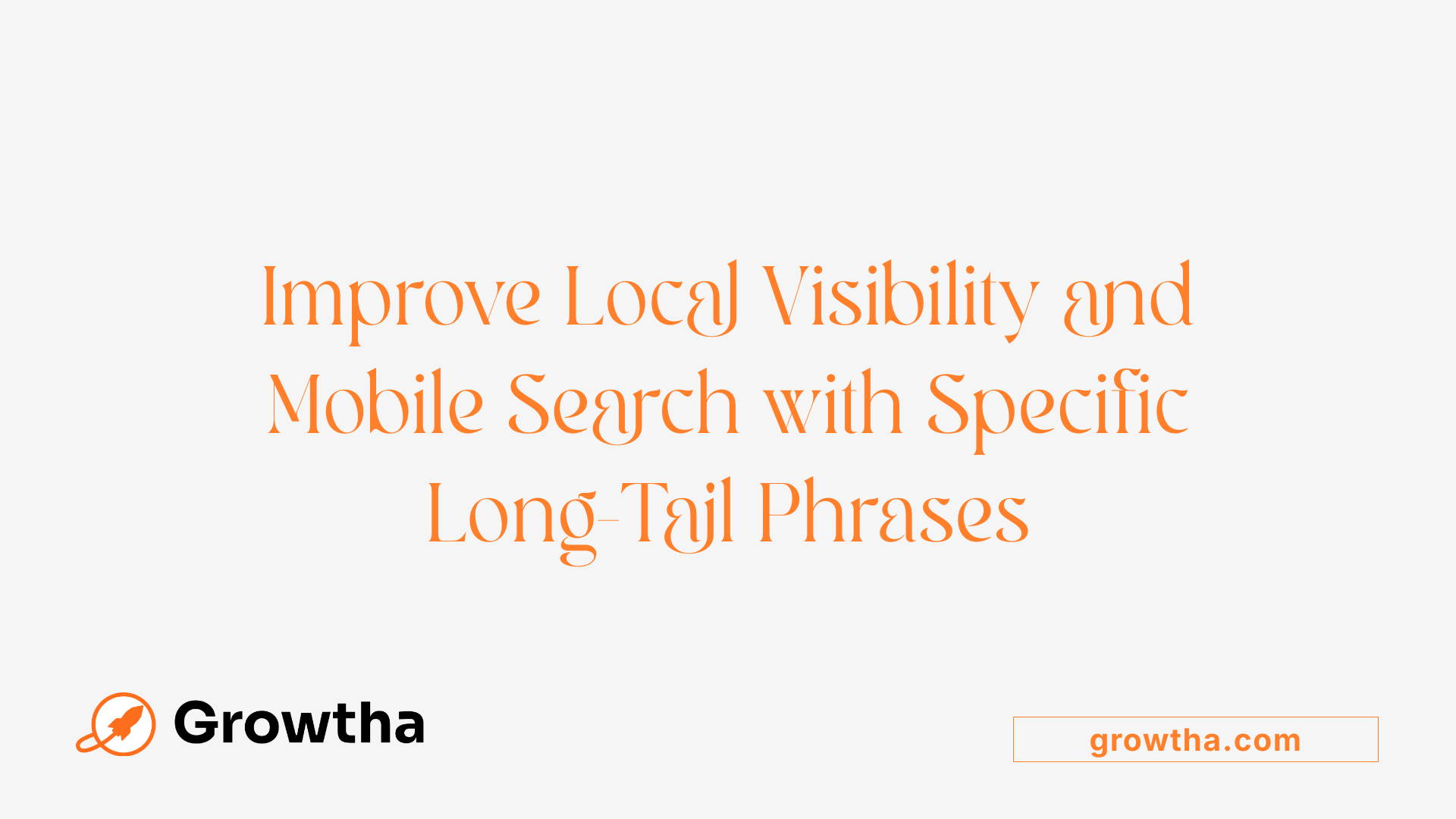Long-Tail Keywords That Attract New Patients
Unlocking Growth: How Long-Tail Keywords Transform Healthcare Patient Acquisition


Long-Tail Keywords That Attract New Patients
Harnessing the Power of Specific Search Phrases in Medical SEO
In today’s digital age, healthcare practices that leverage long-tail keywords experience significant improvements in online visibility, patient engagement, and service conversions. With over 91% of search queries being long-tail, and approximately 73% of consumers actively researching treatments online, the strategic use of these detailed search phrases is essential for any medical practice aiming to attract new patients and dominate local search results.
Understanding Long-Tail Keywords and Their Importance in Healthcare SEO

What are long-tail keywords and why are they important in healthcare SEO?
Long-tail keywords are longer, more specific search phrases that usually contain three or more words. Unlike broad, generic keywords, these phrases closely reflect the natural language and precise intent of the user. For example, instead of searching for
Strategies for Identifying Effective Long-Tail Keywords in Healthcare
 In the highly competitive landscape of healthcare marketing, pinpointing the right long-tail keywords is crucial for attracting targeted patient traffic. Healthcare providers can start by employing various research tools. For instance, Google Trends offers insights into trending health topics and seasonal fluctuations, guiding content planning around current patient interests.
In the highly competitive landscape of healthcare marketing, pinpointing the right long-tail keywords is crucial for attracting targeted patient traffic. Healthcare providers can start by employing various research tools. For instance, Google Trends offers insights into trending health topics and seasonal fluctuations, guiding content planning around current patient interests.
Google Keyword Planner is another vital tool, helping identify relevant, low-competition phrases that patients frequently search for. This platform also provides data on search volume and cost-per-click (CPC), enabling practices to prioritize keywords with high relevance and potential return on investment.
Analyzing actual search query data from Google Search Console and website analytics reveals what visitors are actively looking for. These insights highlight specific patient needs and language, allowing practices to tailor their content accordingly.
Beyond basic tools, competitor analysis plays an important role. Using SEO platforms like SEMrush or Ahrefs, practices can identify high-performing keywords competitors rank for, uncovering opportunities to differentiate or target underserved niches. Industry sources such as PubMed or BioSpace can also reveal niche health topics gaining attention.
Creating detailed patient personas further refines keyword strategy. By understanding the demographics, common health concerns, and search behaviors of target audiences, providers can develop highly relevant long-tail phrases.
To generate targeted keywords, exploring Google’s autocomplete suggestions and related searches provides natural, user-driven ideas for specific health queries. Organizing these phrases into thematic groups based on patient intent — informational, navigational, or transactional — supports a structured SEO approach.
A strategic combination of these methods—supported by continuous analysis and refinement—empowers healthcare practices to build an effective long-tail keyword portfolio. This targeted approach not only improves search engine rankings but also increases trustworthiness by delivering content directly aligned with patient needs, ultimately driving both online visibility and patient conversions.
Creating Content Around Long-Tail Keywords to Engage Patients

How can healthcare practices optimize their website content with long-tail keywords?
Healthcare practices can enhance their search engine presence by carefully integrating long-tail keywords into various content elements on their website. The process begins with thorough keyword research using tools like Google Keyword Planner, SEMrush, or Ahrefs. These tools help identify phrases that are specific, relevant, and have low competition, allowing practices to target patient search intents effectively.
Once identified, these long-tail keywords should be naturally incorporated into key areas such as page titles, headers, meta descriptions, and within the main content of blog posts, FAQ pages, and service descriptions. This ensures that search engines understand the relevance of the pages to particular search queries, increasing their chances of ranking higher in local search results.
Understanding the search intent behind each keyword is essential. For example, informational keywords attract users seeking general knowledge, while transactional keywords aim at users ready to book services. Tailoring content to match these intents improves engagement.
In addition to keyword placement, technical SEO factors like website speed, mobile-friendliness, and security should be optimized, aligning with Google's E-E-A-T guidelines (Experience, Expertise, Authority, Trustworthiness). These practices further boost rankings and signal credibility to search engines.
Regularly monitoring performance metrics such as search rankings, click-through rates, and user engagement helps practitioners refine their keyword strategies. Updating content periodically ensures continued relevance and competitiveness.
In summary, effective optimization involves rigorous research, natural keyword inclusion, technical enhancement, and ongoing evaluation—culminating in content that attracts targeted local traffic and builds authority within the healthcare niche.
Using Long-Tail Keywords to Enhance Local and Mobile SEO

How can long-tail keywords be used to improve online visibility for healthcare providers?
Long-tail keywords serve as a powerful tool for healthcare practices aiming to boost their online presence. Since these keywords are highly specific, they align more closely with what prospective patients are searching for, increasing the chances of rankings and attracting relevant traffic.
By incorporating detailed, niche phrases into website content, practices can target particular conditions, treatments, or local areas. For example, a practice might optimize for phrases like 'pediatric speech therapy in Brooklyn' instead of just 'speech therapy'. This specificity helps the practice appear in local search results and voice searches, which often include longer, natural language questions.
Additionally, creating FAQ pages or blog posts that answer common patient questions using long-tail keywords enhances visibility. Content structured around these keywords can appear in snippets or answer boxes, further boosting organic visibility. Overall, strategic use of long-tail keywords allows healthcare providers to reach their target audiences more effectively, establish niche authority, and foster trust within their communities.
Implementing SEO Best Practices with Long-Tail Keywords

What are best practices for healthcare providers to incorporate long-tail keywords into SEO efforts?
Healthcare practices should begin with detailed keyword research to identify patient-centered, high-intent phrases relevant to their services. Tools like Google Keyword Planner, SEMrush, and Ahrefs are invaluable in uncovering long-tail keywords such as "pediatric speech therapy in Brooklyn" or "affordable dental implants near me." Once identified, these keywords should be thoughtfully integrated into website content, including service pages, FAQs, and blog articles. Creating dedicated pages for specific services and optimizing with these keywords enhances relevance and visibility.
On-page optimization should include naturally embedding long-tail keywords in page titles, headers, and meta descriptions. This signals search engines about the page’s content focus, making it easier for them to rank the page accordingly. Additionally, practices should develop content around common patient questions, using long-tail phrases to improve chances of appearing in featured snippets and voice searches.
How do long-tail keywords help improve online visibility for healthcare providers?
Long-tail keywords improve online visibility by targeting very specific search queries that potential patients use. Unlike broad keywords, long-tail phrases face less competition, making it easier to rank high in search results, especially for localized searches.
They are particularly effective in capturing high-intent visitors who are closer to making an appointment. For example, a long-tail keyword like "best allergy doctor in Dallas" attracts individuals actively seeking allergy treatment, increasing the odds of conversion.
Furthermore, incorporating geographic terms such as "near me" or city names taps into local SEO opportunities, which are crucial for healthcare practices aiming to attract nearby patients. Optimized content that answers specific patient questions using long-tail keywords also enhances the chances of being featured in Google snippets, further boosting visibility.
How can healthcare practices optimize their website content with long-tail keywords?
Optimizing website content involves multiple strategic steps. First, create high-quality, detailed content (around 800-1000 words) centered around chosen long-tail keywords. This includes crafting informative articles, FAQs, and service descriptions that naturally incorporate these phrases.
Next, ensure that each page’s title tags, headers, and meta descriptions include relevant long-tail keywords to improve relevance signals to search engines. Internal linking between related pages using these keywords can also strengthen overall site authority and improve navigation.
Local SEO is enhanced by listing practices accurately on Google My Business, including geographic keywords in listings, and encouraging patient reviews that mention specific services or locations. Adding relevant images and videos that include keywords in alt text further supports SEO efforts.
Finally, regularly monitor and update content based on keyword performance data from analytics tools. Staying adaptive to trending search terms and refining content ensures sustained relevance and search ranking success in the highly competitive healthcare environment.
Maximizing Long-Tail Keyword Strategies for Sustainable Growth
Harnessing the full potential of long-tail keywords is indispensable for healthcare practices aiming to boost their online presence and attract high-quality, qualified patients. By systematically researching, implementing, and continuously refining long-tail keyword strategies, providers can ensure improved search rankings, increased local visibility, and heightened patient trust. Tailoring content to match patient search intent at each stage of their decision-making journey and optimizing for local and voice search not only enhances user experience but also leads to measurable growth. The future of healthcare marketing lies in precision, relevance, and targeted digital outreach—principles embodied by effective long-tail keyword use, which ultimately paves the way for long-term success.
References
- Choosing the Right Long Tail Keywords for Your Medical Practice
- Long Tail SEO Keywords for Medical Practices - WebFX
- Long-tail Medical Keywords - Haden Interactive
- Healthcare Keywords to Include in Your Website's Healthcare SEO
- Understanding How Potential Patients Use Keywords To Find A ...
- Boost Life Sciences SEO: Mastering Long-Tail Keywords for Success
- Advanced Keyword Research Techniques to Target High-Intent ...
- Drive More Traffic to Your Healthcare Website with Long-Tail ...







